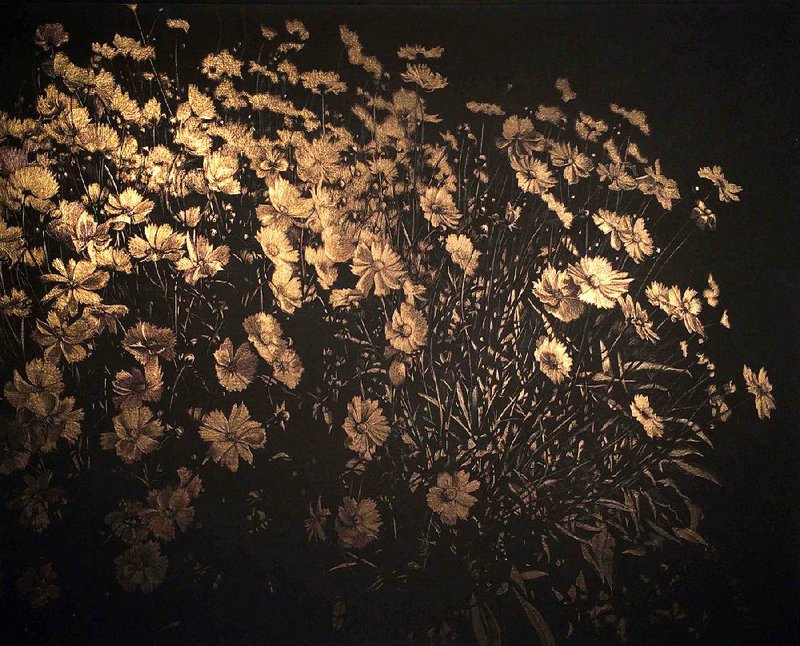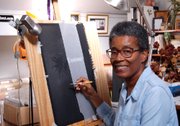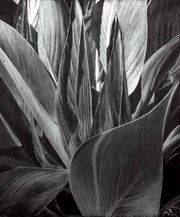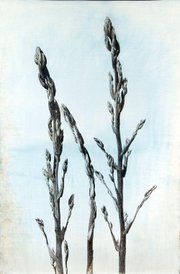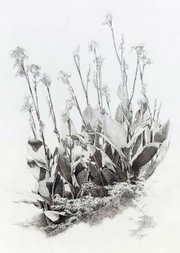Sunlight filters in through the half-open window shades, classical music floats on the air and a mug of green tea is steeping on the coffee table in Marjorie Williams-Smith's house.
It is in this atmosphere, carefully curated to be as calming as possible, that Marjorie, 64, leaves the stress of the world behind to make her art.
She's a private person who declines to discuss most aspects of her personal life -- she is hesitant to tell even the names of her children or to show off her home studio. But when she talks about art, her eyes light up and her mouth stretches into a shy smile. She's ready to talk history of silverpoint, to demonstrate how the medium works and to display some of her old works.
Viewers can see hints at who she is through her art, the intricate garden she draws into existence with mechanical pencils filled with metal rods instead of lead.
She said it's a spiritual undertaking to draw the flowers, often long-stemmed, often on small surfaces, always meticulously done.
"I'd feel this creative energy, and just kind of reconnect with a spiritual sort of experience," Marjorie said. "So, that's kind of where some of my images are coming from now, just reconnecting and giving praise for creation."
One piece completed in 1988, Trio, shows three roses, their stems overlapping and leaves starting to curl at the edges, in three types of metal -- gold, copper and silver. They appear to be on the verge of slipping into the white background of the work.
In a more recent work from 2016, Face the Sun, golden daisies emerge from a black background, their petals open to the light.
Silverpoint, which dates to the Renaissance, is etched onto a coated paper with silver rods. It is one of the least commonly used mediums in the art world.
The metal won't transfer to notebook paper because it is too soft, so silverpoint artists need to use a clay coating or Gesso, a sharp-scented white paint mixture.
The medium is unforgiving. Once a mark is made, it cannot be erased; the artist has to start over or accept the mistake as a part of the piece.
. . .
Marjorie started out with pencils and watercolors, which can be erased or painted over, when she was a child. In school, she always looked forward to Christmastime because it was when the students were allowed to spend more time drawing than usual.
The art store was one of her favorite places to go as a child growing up in Washington, D.C.
She rode the bus to look at art magazines and stock up on pencils and watercolors, and would beg her mother to buy new coloring books when they went grocery shopping at the Five & Dime General Store just a few blocks from her house.
Marjorie studied art in college at Howard University and worked as a graphic designer in New York for a few years before her husband, Aj Smith, got a job in Little Rock in 1982 at the Arkansas Arts Center. Eventually, both began teaching at the University of Arkansas at Little Rock.
She taught primarily graphic design and basic drawing classes, but retired recently after 33 years at the university.
"It got to the point where I wasn't spending as much time in the studio as I wanted to," Marjorie said. "I would rely on holiday breaks and the summer. Now, I get to spend more of the day working on my art and just taking care of myself."
She laughs when she talks about how she used to get some of the flowers she drew out of the trash can at school after receptions; her fascination with flowers began when she got a bouquet for her birthday and wanted to preserve them.
"When I was growing up, if you wanted to save something, you put it in a book and pressed it -- even flowers, but I always thought 'I'm smashing this flower,'" she said. "I really loved the form, and I wished there was some other way that I could have it without smashing it."
She found the solution in art, saving floral arrangements after parties, from the centerpieces on friends' dining room tables or photographing living flowers growing in her neighbor's yard.
"It [the flower] became a symbol of strength and fragility, and that just kind of evolved to wanting for myself this quiet moment with this form," she said.
While Marjorie's work is intended to give viewers a break from reality, most of the artists she lists as her favorites -- Elizabeth Catlett and Kathe Kollwitz -- draw with bold lines depicting issues of oppression and poverty.
Her husband, Aj, has been working on a series of drawings called "Faces of the Delta," that captures culture in the Arkansas and Mississippi Delta in graphite pencil.
The couple has shown together several times; they were the featured artists in the Silver Anniversary show at Hearne Fine Art, a downtown Little Rock gallery. One of their largest shows was "Two Artists, Two Visions," which showed in 2011 in Indiana.
Aj said since Marjorie started silverpoint in 1980, he has not seen much change in his wife's underlying theme in her art.
"I guess in the past 20 or 25 years or so, I see different images, but I see different facets of the same message," he said.
The two used to share a studio space, but have such different creative styles that they had to get separate spots. He is animated and listens to talk radio. She is meditative and likes her classical music or jazz if she has already "solved the complexity of the drawing."
. . .
Marjorie said one of the things she likes best is to capture the flower's thorns -- they show toughness in fragility and an edge to the delicate escape from life she tries to capture.
For her, that sharpness has emerged again as she tries to portray a feeling she can't quite put into words. It's not quite injustice, not quite discrimination, but a sense of unrest in today's political climate.
"I've got some ideas for images that still uses my flowers, but to address some of what I feel right now in terms of just -- I don't know how to describe it," she said.
Garbo Hearne, owner of Hearne Fine Art, has represented Marjorie's work for almost 20 years, and said simply working in silverpoint makes a statement.
"She is an African-American, woman artist who has approached and conquered this medium," Hearne said.
Mastering silverpoint took Marjorie years of study and trial-and-error approaches, she said.
Marjorie first discovered silverpoint in the 1980s at an exhibition at the Arkansas Arts Center. She went back several times to study the works, and bought a book outlining how to do silverpoint.
"Going to see this show was like an eye-opening experience," she said. "And to see all these contemporary artists working in this medium, it was just gorgeous."
She went shopping, ready to try out metalwork, but bought the wrong materials. So, Marjorie scrounged up some of her old silver jewelry and used that to draw on acrylic Gesso she bought at the art store.
The result wasn't what she wanted, so she went back to look more closely at the works at the Arts Center and discovered that rather than allowing lines to simply flow into one another, the artists used a cross-hatching technique on their works to create a textured look.
"I put the silverpoint away for a little bit, and got my pen and ink out and just did pen-and-ink line drawings, just to get the feeling of the line and how to control this mark-making," Marjorie said.
For all of her efforts to maintain control -- from her propensity for waiting until flowers are dead to draw them so they don't move, to the composed environment in which she works -- she cannot control her medium.
Silverpoint, unlike watercolor or graphite, does not fade over time. Light and air have the opposite effect on the metal, which tarnishes, morphing from light gray to a warm brown.
"Ten years from now, a picture will mature," Hearne said, crossing her arms and gazing at one of Marjorie's small, framed pictures in the gallery. The gallery features black art and literature.
The image was of two roses, leaning in toward each other as to hear a whispered secret. Marjorie's pieces give flowers personality, Hearne said, which is part of what keeps people coming back for more.
"She's been successful, I think, in selling her work," Hearne said. "Once you have one, you want another."
Marjorie's website (marjoriewilliams-smith.com) has a few dozen samples of her work -- flowers drawn in different metals, some pieces dating to the 1980s.
A few have black backgrounds made from Gesso, others show her experimentation with watercolor for a background, but all of them take the same emphasis on lines and forms.
Marjorie's online artistic statement gives little insight into her mind. It focuses on the flowers, explaining what she wants her audience to glean from the work:
"Most often these flowers are dried and seem to have another life beyond their present fragile state. They represent the passage of time, energy, life and spirit."
Style on 01/07/2018

